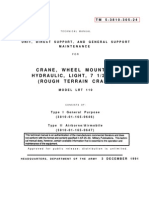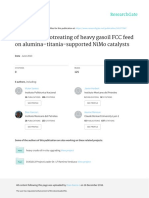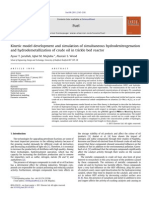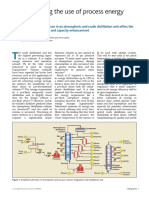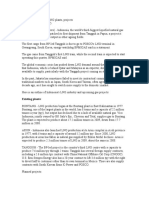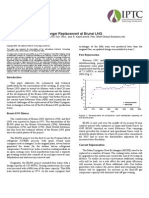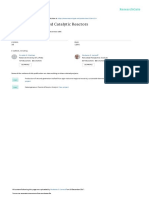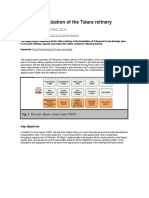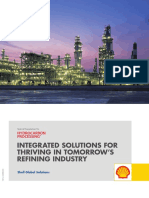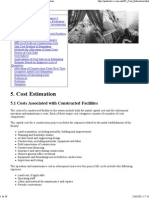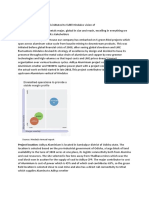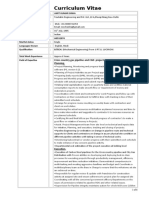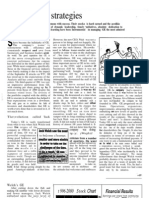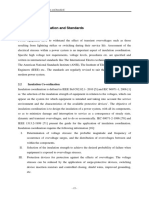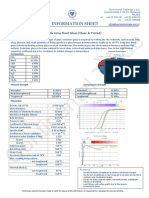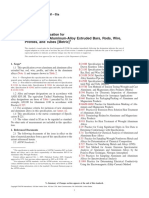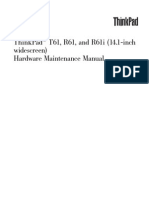R 32
R 32
Uploaded by
Shaunak VaidyaOriginal Description:
Original Title
Copyright
Available Formats
Share this document
Did you find this document useful?
Is this content inappropriate?
Copyright:
Available Formats
R 32
R 32
Uploaded by
Shaunak VaidyaCopyright:
Available Formats
Project Monitoring of Turnkey Projects A Study of Panipat Refinery
Project management of Turnkey Projects from an owners prospective involves special emphasis on Project Monitoring skills, critical interventions from time to time and induction of innovative steps to boost the project progress and keep the project on track. The case study of the success story of MS Quality Up-gradation Project at Panipat Refinery, Indian Oil Corporation Ltd., India, emphasizes the interesting issues pertaining to the means and methods the project was put back on track which was facing some rough weather during execution at one point of time and was successfully completed and commissioned as per target.
lans are only good intentions unless they immediately degenerated into hard work (Peter Drucker, Readers Digest, March 1998). To make such a transformation
possible is no easy task unless all-out efforts are made by the project team, and the client has an important role in this endeavor. A case study of MS quality up-gradation project depicts it all.
MS Quality Up-gradation Project: A Synopsis
The MS Quality Up-gradation Project was undertaken at Panipat Refinery to produce improved quality components for MS blend thereby enabling the refinery to
R E P O R T
Project Management
32
HYDROCARBON ASIA, OCT-DEC 2010 Visit our website at: http://www.safan.com
Figure 1. MSQUP Block Flow Diagram
produce MS products meeting Euro-III/ Euro-IV equivalent specs. The Euro norms basically give limiting values of emissions coming out of new vehicles under standard driving conditions with reference fuel. These norms aim at improving quality of fuel by achieving reduction in benzene, sulphur, olefins & aromatic contents and improvement in octane number. Quality up-gradation projects have followed time bound implementation as per judicial guidelines and have now become projects working on Operating Necessity model. Further quality being one of the key aspects of the companys new vision, these projects are in sync with the companys strategic objectives. Process involved in the project A block flow diagram of MSQUP project which gives a birds eye view of the processes involved in the project is presented in Figure 1.
Execution Methodology Adopted The plant was divided into two LSTK packages namely EPCC-I (ISOM Units: NHT, RSU & PENEX and off-sites facilities & Tankages) which was executed by M/s L&T and EPCC-II (PRIME-G+: FCC GDS) which was executed by M/s Toyo India. The Project Management consultant was M/s Jacobs Engineering India Pvt. Ltd. It was observed that the EPCC-I package execution was going on well but the EPCC-II package, which was lined up after seven months of EPCC-I go ahead, needed some special emphasis on project performance and to match the completion schedule of EPCC-I so that integrated commissioning of the MSQ plant could be achieved. The interface issues where the roles of PMC and Owner became extremely important especially involving common pipe rack and off-site facilities and execution philosophy of EPCC-II due to the compact design of FCC-GDS section.
Strategies and Implementation
Strategic approach during engineering, procurement, planning and execution phase is required from Owners perspective to speed up the progress of the project and guide the entire Project Team to achieve the objective of safe and timely completion of the project. The various strategies, along with meticulous monitoring, adopted and implemented in execution of MSQUP project at Panipat Refinery to speed up the projects progress, to overcome interface issues of different LSTK packages and to go for integrated commissioning of entire project are listed below. A. Project Monitoring and Controlling The construction progress backlog in EPCC-II LSTK package in February 2009 was observed to be hovering around 7% and the trend was increasing which was alarm-
HYDROCARBON ASIA, OCT-DEC 2010
33
ing. On IOCLs initiative, a series of brain storming sessions were done with LSTK agency and PMC to improve upon the progress and put the project on track. Project monitoring called for high level interaction with LSTK agency to bring forth concrete measures quickly to arrest further delays and cover up backlog in 3 to 4 successive months. This followed strategic actions and concurrent working on all fronts with meticulous planning which resulted into achievement of over 9 % construction progress consistently for four months (March 2009 to June 2009) which is a bench mark (Figure 2). B. Strategic Actions by Owner to Expedite Project Progress
Parallel works on various fronts - Concurrent construction activities were taken up to expedite job progress in tight project schedule. 1. After 20% piling work, civil foundation work started simultaneously with proper site planning. Structural work also started concurrently once sufficient front has been generated from civil foundation work. 2. Equipment erection started on getting the civil foundation front one by one. Pip-
ing fabrication work started along with start-up of structural work and piping erection activities were taken up as soon as the rack was ready. 3. Electrical & Instrument cable laying jobs also got advanced in similar fashion. Regular monitoring with respect to Contractors Mobilization vis--vis available front. 1. Regular monitoring of Contractors key skilled persons like welders, fitters, carpenters, masons and resources like piling rig, crane, welding machines etc. was carried out by IOCL project team with respect to available front and they were
Figure 2. Construction Progress curve of EPCC-II of MSQ
Projektleitung
34
HYDROCARBON ASIA, OCT-DEC 2010
Visit our website at: http://www.safan.com
regularly pressurized for adequate mobilization to expedite project progress. Equipment deliveries matched with readiness of equipment foundation at site. 1. Endeavour was made to erect the equipment directly on equipment foundation as soon as it is delivered at site. In close follow-up with LSTK agency, vendors were asked to advance the delivery schedule of equipments. Expediting actions were also taken at vendors works to expedite manufacturing and delivery. 2. Meticulous planning and even staggering of equipment deliveries to match with site erection plan of equipment was done to generate front for subsequent piping works to speed up the job progress. Formation of core-group in advance for better coordination in project. 1. Multi-disciplinary core group was formed around 6 to 8 months before mechanical completion of project for check-listing and coordinating pre-commissioning and commissioning activities and to facilitate smooth handing and taking over. Innovative methods used to advance project execution. 1. Use of pre-cast cable trench sections and pre-cast manholes in place of in-situ RCC casting to save time and generate front for subsequent project activities. 3. Use of ultrasonic testing (UT) in place of conventional radiography for dome roof
isomerate tank for welding quality assurance to expedite work progress. 4. Use of Total Stations for all surveying and layout works in place of Thedolite/ level instruments. 5. Use of more radiography sources of low curie for radiography of piping joints as the plant was compact and higher strength sources may cause radiography interference. Specialized agencies for critical jobs - LSTK agency was categorically instructed to deploy specialized agencies for critical and precision jobs like chemical cleaning of lines, refractory dry-out, catalyst loading in reactors, etc, to complete the safely in one go. C. Challenges Over come : Strategic Intervention by Owner Delay in completion of cooling water circuit was averted by deriving an alternate way of tapping cooling water. After brainstorming, it was thought prudent to go for HOT TAPPING from existing cooling water circuit for MSQ and later connect existing circuit with refinery network. This is how cooling water circuit was laid for MSQ timely. Supply of two long lead items namely MUG compressors and reactors of FCC GDS were kept under Owners scope and these were given as Free Issue Materials to LSTK agency. The deliveries were closely monitored and rigorous follow-up were done for timely delivery. Compressor motor was received at site from M/s Lohar, Germany in August 2009 just on time. Compressors were
HYDROCARBON ASIA, OCT-DEC 2010
35
finally received and erected in supervision of M/s BPCL, India who was supplier of compressor package. Compressors associated piping and instrumentation items were also lifted strategically from BPCLs work to site and fabricated and assembled to save project time. IOCL team monitored and reduced the manufacturing cycle time of reactors in close working with manufacturer (M/s ISGEC, India) and expedited with M/s ISGEC to complete the reactors phase wise matching with erection schedule at site. All reactors were received progressively at site (one by one) which helped the site team in erection and piping and structural jobs of reactors in time. Since there was a common PMC (M/s Jacobs, India), for both EPCC contracts, integrated approach could be followed and Golden Joints interface could be achieved. A lot of interphase issues of site as well as engineering issues could be immediately resolved due to common PMC. Dome roof storage tank of Isomerate (15000 KL capacity) involved huge quantum of radiography of weld joints which was time consuming and activity was on critical path. Issue was resolved by replacing radiography with phased array Ultrasound testing (UT) in consultation with PMC and LSTK agency and target was achieved well on time. The problem of different inert levels brought out the learning that practical feasibility of proposed facilities needs to be verified while executing jobs in an existing setup. It is beneficial for the project to
detect and resolve the problems before commissioning. Strategically, no load trial run of all motors was conducted with the help of construction power. It helped in motors health diagnosis at early stage. Similarly, heater dry out was also carried out by external arrangement (without system completion and burners in line) to save commissioning time. Integrated commissioning of all work packages results in reduction in commissioning time. In MSQUP at Panipat, integrated commissioning has taken place in both the EPCCs as a part of systematic unit wise commissioning plan to reduce commissioning time.
a watch guard of quality assurance and safety management at site. Project monitoring and strategic intervention by Owner from conceptualization phase to engineering and during execution phase help arrest project slippages and aids in securing successful timely completion of time bound projects like MS quality up-gradation project which have high stakes in business sustainability. This not only achieves the project objective of completing the project without cost and time over-run but also increases the confidence of operation group in smooth commissioning and reliability in operation thereafter.
References
1. P r o j e c t M a n a g e m e n t - A managerial approach, Jack R Meredith, Samuel J Mantel Jr. 6th edition 2008 2. Monthly Project progress reports of MSQ Project, PR,IOCL 3. Process data book of MSQ project, PR,IOCL HA
Conclusion
Participation of owners team acts as a catalyst not only in fast resolution of engineering issues but also speeding up the construction work progress safely. The project team of owner becomes
This publication thanks Mr. Arvind Kumar and Mr. PPS Paul for providing this article. Mr. Arvind Kumar is Chief Project Manager in Panipat Refinery of Indian Oil Corporation Ltd., India. He has worked for Indian Oil Corporation Ltd. for more than 20 years in different refinery units. Mr. Arvind Kumar has performed assignments in Design & Engineering and in Project Management. He has successfully executed various greenfield and revamp projects of refineries along with commissioning. He holds a B. Tech. degree in Mechanical Engineering from KNIT, Sultanpur, India and an MBA with specialization in Operation Management from IGNOU, New Delhi. He is a gold medalist in CPM (Project Management) from U21 Global, NUS, Singapore. PPS Paul is Dy. General Manager (Projects) in Panipat Refinery of Indian Oil Corporation Ltd., India. He has worked for Indian Oil Corporation Ltd. for more than 29 years in different refinery units. Mr. Paul has performed assignments in various greenfield and brownfield projects and in petroleum conservation and research fields. He holds a B.E. degree in Mechanical Engineering from Punjab University, Chandigarh, India with specialization in Operation Research.
Projektleitung
36
HYDROCARBON ASIA, OCT-DEC 2010
Visit our website at: http://www.safan.com
You might also like
- TM 5-3810-305-24 LRT 110 CraneDocument869 pagesTM 5-3810-305-24 LRT 110 CraneAdvocate100% (4)
- Report On Inventory of Property and EquipmentDocument3 pagesReport On Inventory of Property and EquipmentYzanariz Villaruel75% (4)
- FTE Vs FTDocument43 pagesFTE Vs FTFrank Araya Diaz100% (4)
- ManualAspen Physiacal PropertiesDocument448 pagesManualAspen Physiacal Propertiesprafulla1983Noch keine Bewertungen
- Egeberg 2010 - Hydrotreating in The Production ofDocument13 pagesEgeberg 2010 - Hydrotreating in The Production ofNadia RizanedewiNoch keine Bewertungen
- Horizontal Cyclone in Closed-Circuit Grinding: Eliminated Horizontal Mounting PermitDocument5 pagesHorizontal Cyclone in Closed-Circuit Grinding: Eliminated Horizontal Mounting PermitGerzain CarrilloNoch keine Bewertungen
- From BS 8102: 1990: Table 1. Guide of Level of Protection To Suit Basement UseDocument1 pageFrom BS 8102: 1990: Table 1. Guide of Level of Protection To Suit Basement UseKaren Boyd0% (1)
- Road Map Update for Carbon Capture, Utilization, and Storage Demonstration and Deployment in the People’s Republic of ChinaFrom EverandRoad Map Update for Carbon Capture, Utilization, and Storage Demonstration and Deployment in the People’s Republic of ChinaNoch keine Bewertungen
- Boiler+Electrification Final+Rev2Document93 pagesBoiler+Electrification Final+Rev2Anubhav SinghNoch keine Bewertungen
- Catalytic Hydrotreating of Heavy Gasoil PDFDocument9 pagesCatalytic Hydrotreating of Heavy Gasoil PDFVishal GoswamiNoch keine Bewertungen
- Qap KLMDocument200 pagesQap KLMSachin JadhavNoch keine Bewertungen
- HDT of DieselDocument17 pagesHDT of DieselIzack Silva S100% (1)
- Hydrotreating Catalysts, An Old Story With New ChallengesDocument17 pagesHydrotreating Catalysts, An Old Story With New ChallengesJulio Adolfo López PortocarreroNoch keine Bewertungen
- Hydrotreating Installed Cost: IncludesDocument1 pageHydrotreating Installed Cost: IncludessapooknikNoch keine Bewertungen
- Overall Block Diagram: Technology & Development General DepartmentDocument1 pageOverall Block Diagram: Technology & Development General DepartmentAhmed HassanNoch keine Bewertungen
- Hcmut Training-2 CBMDocument44 pagesHcmut Training-2 CBMAnre Thanh Hung100% (1)
- Microsoft PowerPoint - Flaresim 3Document25 pagesMicrosoft PowerPoint - Flaresim 3ijaz fazilNoch keine Bewertungen
- The Gorgon LNG ProjectDocument10 pagesThe Gorgon LNG ProjectthawdarNoch keine Bewertungen
- Maximising The Use of Process EnergyDocument9 pagesMaximising The Use of Process Energymarocos1234Noch keine Bewertungen
- Indonesia LNGDocument22 pagesIndonesia LNGcrys100% (1)
- Contributors To Refinery FlaringDocument3 pagesContributors To Refinery Flaringrvkumar61Noch keine Bewertungen
- Enhancement of Hydrotreating Process Evaluation: Correlation Between Feedstock Properties, In-Line Monitoring and Catalyst DeactivationDocument13 pagesEnhancement of Hydrotreating Process Evaluation: Correlation Between Feedstock Properties, In-Line Monitoring and Catalyst DeactivationLeila Salim LealNoch keine Bewertungen
- Oil Refinery Information SourcesDocument5 pagesOil Refinery Information SourcesBien Molintapang BastianNoch keine Bewertungen
- Flare Minimization Strategy For Ethylene PlantsDocument7 pagesFlare Minimization Strategy For Ethylene Plantsysh11Noch keine Bewertungen
- Aspen: User Guide Volume 2Document372 pagesAspen: User Guide Volume 2vsraochemical1979Noch keine Bewertungen
- Brunei MCHE Replacement 2005 IPTC-10676-MS-P PDFDocument3 pagesBrunei MCHE Replacement 2005 IPTC-10676-MS-P PDFGeoff HunterNoch keine Bewertungen
- Ar001Document10 pagesAr001Gary ClarkNoch keine Bewertungen
- CASE STUDY-Rockwell PetroleumDocument2 pagesCASE STUDY-Rockwell Petroleumanurag10julyNoch keine Bewertungen
- Polymers Plus User Guide Volume 2Document356 pagesPolymers Plus User Guide Volume 2Daniel Pedrosa LopesNoch keine Bewertungen
- Get More LifeDocument4 pagesGet More LifeSalim YilmazNoch keine Bewertungen
- Green Blue Ammonia Value ChainDocument8 pagesGreen Blue Ammonia Value ChainIvanakbar PurwamaskaNoch keine Bewertungen
- Technical Note: GTL Feasibility Study Phase 1 - Summary StatementDocument4 pagesTechnical Note: GTL Feasibility Study Phase 1 - Summary StatementPillai S KumarNoch keine Bewertungen
- Productivity Analysis of EPC WorksDocument8 pagesProductivity Analysis of EPC Workssimeonochiche3640Noch keine Bewertungen
- Red Sea Petrochemicals Project Concept Note - Rev-01Document8 pagesRed Sea Petrochemicals Project Concept Note - Rev-01E BNoch keine Bewertungen
- Market Data Book 2015 ProspectusDocument6 pagesMarket Data Book 2015 ProspectusPanosMitsopoulosNoch keine Bewertungen
- Modeling of Fixed Bed Catalytic Reactors: Computers & Chemical Engineering December 1985Document12 pagesModeling of Fixed Bed Catalytic Reactors: Computers & Chemical Engineering December 1985sergioln001Noch keine Bewertungen
- CCS Technology Status and OutlookDocument48 pagesCCS Technology Status and Outlookrecsco2Noch keine Bewertungen
- CAT-16-6 Intro To CRC-FCC Qunzhu Li-Luoyang Weida Petrochemical Eng CoDocument54 pagesCAT-16-6 Intro To CRC-FCC Qunzhu Li-Luoyang Weida Petrochemical Eng CoAle SanzNoch keine Bewertungen
- Mea E11a B ShortDocument15 pagesMea E11a B ShortMeli GerberNoch keine Bewertungen
- Managing Small and Medium-Sized Capital Projects - Chemical EngineeringDocument8 pagesManaging Small and Medium-Sized Capital Projects - Chemical EngineeringKevin DrummNoch keine Bewertungen
- Preface: Technology Is The Making, Modification, Usage, and Knowledge of ToolsDocument44 pagesPreface: Technology Is The Making, Modification, Usage, and Knowledge of ToolsÅrñäb Røy100% (1)
- Engineering EstimateDocument16 pagesEngineering EstimateLixin YangNoch keine Bewertungen
- Use Electric Heaters HazardousDocument3 pagesUse Electric Heaters Hazardousn.hartonoNoch keine Bewertungen
- Diesel HydrotreatingDocument6 pagesDiesel HydrotreatingArchana RaviNoch keine Bewertungen
- Economic Analysis MethanolDocument23 pagesEconomic Analysis MethanolprablesekhriNoch keine Bewertungen
- Modernizacion de Refineria Talara PeruDocument4 pagesModernizacion de Refineria Talara PeruAngelo HurtadoNoch keine Bewertungen
- GTL Technology Small Scale - by V.wanDocument11 pagesGTL Technology Small Scale - by V.wanDebye101Noch keine Bewertungen
- Integrated Solutionsthriving PDFDocument20 pagesIntegrated Solutionsthriving PDFJorge RodriguezNoch keine Bewertungen
- WPI Combined CycleDocument2 pagesWPI Combined CycletahirNoch keine Bewertungen
- Economic Evaluation of NGL Recovery Process Schemes For Lean Feed CompositionsDocument10 pagesEconomic Evaluation of NGL Recovery Process Schemes For Lean Feed CompositionsFranco Camacho CanchariNoch keine Bewertungen
- Techno-Economic Performance of The Coal-To-olefins Process With CCSDocument10 pagesTechno-Economic Performance of The Coal-To-olefins Process With CCSAlbertus ArdikaNoch keine Bewertungen
- Align Your Automation Plan To Your Business Objectives: Front End Engineering Design CapabilitiesDocument4 pagesAlign Your Automation Plan To Your Business Objectives: Front End Engineering Design CapabilitiestechbhaskarNoch keine Bewertungen
- Cost Estimation: 5.1 Costs Associated With Constructed FacilitiesDocument38 pagesCost Estimation: 5.1 Costs Associated With Constructed FacilitieskhajaimadNoch keine Bewertungen
- What Is Turnkey ProjectsDocument10 pagesWhat Is Turnkey ProjectsWalid KarmouzNoch keine Bewertungen
- TS 6 - 1 Popi A. NafisDocument14 pagesTS 6 - 1 Popi A. NafisAsep FirmansyahNoch keine Bewertungen
- Combining Pinch and Exergy Analysis ForDocument13 pagesCombining Pinch and Exergy Analysis Forasad0071Noch keine Bewertungen
- 002 Tacr enDocument233 pages002 Tacr enhandaru dwi yunantoNoch keine Bewertungen
- 2014 PTQ1 HS FCC For Propylene Concept To Commercial OperationDocument7 pages2014 PTQ1 HS FCC For Propylene Concept To Commercial OperationAnonymous v5uipHNoch keine Bewertungen
- Lessons LearnedDocument16 pagesLessons Learneddani2611Noch keine Bewertungen
- Background:: Project Location: Aditya Aluminium Is Located in Sambalpur District of Odisha State. TheDocument6 pagesBackground:: Project Location: Aditya Aluminium Is Located in Sambalpur District of Odisha State. TheNitanshu ChavdaNoch keine Bewertungen
- PMP Certified Project Control Planning Engineer Having More Than 10 Years of ExperienceDocument4 pagesPMP Certified Project Control Planning Engineer Having More Than 10 Years of ExperienceSubin RoshanNoch keine Bewertungen
- 2technical Feasibility ReportDocument4 pages2technical Feasibility ReportHimanshu BhatiaNoch keine Bewertungen
- CV-Amit SinhaDocument6 pagesCV-Amit Sinharanjan sahooNoch keine Bewertungen
- Article For SK RFCC Project - ERTC-final-2Document15 pagesArticle For SK RFCC Project - ERTC-final-2sahkunNoch keine Bewertungen
- Tutorial Critical ChainDocument77 pagesTutorial Critical ChainAntonio CalcinaNoch keine Bewertungen
- The Winning Strategies : and Quality, Company in TheDocument4 pagesThe Winning Strategies : and Quality, Company in TheShaunak VaidyaNoch keine Bewertungen
- CH 5 Test BankDocument10 pagesCH 5 Test BankSehrish Atta100% (3)
- The IT Balanced Scorecard: An Approach For IT Strategy Execution and MeasurementDocument21 pagesThe IT Balanced Scorecard: An Approach For IT Strategy Execution and MeasurementShaunak VaidyaNoch keine Bewertungen
- Hot Air OvenDocument30 pagesHot Air Ovennivesiva24Noch keine Bewertungen
- MOD, 6.283mm Pitch: Worm STEEL 214 M15 - En202Document4 pagesMOD, 6.283mm Pitch: Worm STEEL 214 M15 - En202roger1231175Noch keine Bewertungen
- API Plans FlowserveDocument56 pagesAPI Plans Flowservewwast72100% (5)
- Modular Chiller Heat Pump EnglishDocument17 pagesModular Chiller Heat Pump EnglishAldifirNoch keine Bewertungen
- Concrete Design PDFDocument37 pagesConcrete Design PDFCris BandaNoch keine Bewertungen
- Trial MixDocument7 pagesTrial MixFuadChiwaNoch keine Bewertungen
- Plascoat PPA 571: Proven Performance For Exterior ApplicationDocument20 pagesPlascoat PPA 571: Proven Performance For Exterior Applicationmàrio ferreiraNoch keine Bewertungen
- Chemical Industrial FRP Piping PDFDocument579 pagesChemical Industrial FRP Piping PDFdima100% (1)
- SuhnerBollardsHandrailsTubeCatalogue FINALDocument20 pagesSuhnerBollardsHandrailsTubeCatalogue FINALLee NagleNoch keine Bewertungen
- Heriot-Watt University Malaysia CampusDocument5 pagesHeriot-Watt University Malaysia CampusAsilahNoch keine Bewertungen
- 12 Chapter 2Document16 pages12 Chapter 2Anonymous MDkp0hnb3lNoch keine Bewertungen
- InfoSheet SodaLimeFloatGlassDocument1 pageInfoSheet SodaLimeFloatGlassBansil PatelNoch keine Bewertungen
- Arema Mre 2015 Toc-Vol1 Ch30Document2 pagesArema Mre 2015 Toc-Vol1 Ch30Adnan Hariadi BustamiNoch keine Bewertungen
- Manual M258 PDFDocument160 pagesManual M258 PDFdinojr2010Noch keine Bewertungen
- TECHNICAL SPECS DPWH-LEGAZPI 38m FINALDocument15 pagesTECHNICAL SPECS DPWH-LEGAZPI 38m FINALMEBERUNoch keine Bewertungen
- DEAERATORDocument26 pagesDEAERATORSai Swaroop100% (3)
- Astm b221mDocument14 pagesAstm b221mrandi777770% (1)
- Hardware Maintenance Manual - ThinkPad R61, R61i and T61 14.1inch WidescreenDocument256 pagesHardware Maintenance Manual - ThinkPad R61, R61i and T61 14.1inch WidescreenSetyo Nugroho100% (10)
- Suspension Trasera Volvo Serie PrimaaxDocument60 pagesSuspension Trasera Volvo Serie PrimaaxRicardo Coutiño EscobarNoch keine Bewertungen
- Monkey Ladder Connection HiltiDocument3 pagesMonkey Ladder Connection HiltiAmro Ahmad AliNoch keine Bewertungen
- tm1tEMPLATES MTFDocument23 pagestm1tEMPLATES MTFAnaleen Nolasco100% (1)
- Al Meer Factory Perforated SolidDocument14 pagesAl Meer Factory Perforated SolidSuryaRaoTirumallasettiNoch keine Bewertungen
- Packaging Labelling in Food IndustriDocument41 pagesPackaging Labelling in Food IndustriPrakash KcNoch keine Bewertungen
- CH 400 4-Step Chiller and Heat Pump Controller: General DescriptionDocument6 pagesCH 400 4-Step Chiller and Heat Pump Controller: General DescriptionΓεώργιος ΠαπαδόπουλοςNoch keine Bewertungen
